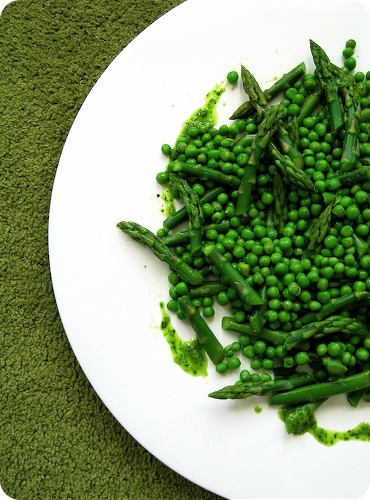Rites of spring
 Tuesday, April 8, 2008 at 2:05PM
Tuesday, April 8, 2008 at 2:05PM 
Around this time two years ago, I was coming up with various uses for peas. Before that, I was all about asparagus. While the grass outside is only showing the barest shades of hopeful green, days of sun and warm breezes have put a definite sense of spring in my step. It is fitting then that this year I am embracing the warmth of recent days by serving both green vegetables.
This simple side can be served warm or at room temperature, offering up sweet and tender-crisp veggies tossed with a vinaigrette that can be called nothing short of enthusiastically herby. Served alongside a seared salmon filet this would make a lovely light supper for these glorious early days of the season.
Spring vegetables with green goddess pesto
While not wholly traditional pesto ingredients, the name refers mostly to the texture of the vinaigrette. The combination was inspired by the original Green Goddess Dressing.
Ingredients
2 shallots, cut in quarters OR 3 green onions, roughly chopped
2 garlic cloves
1/3 cup fresh flat leaf parsley
2/3 cup mixed fresh herbs; whatever combination of chervil, dill, tarragon, lemon thyme and basil you prefer
1-2 anchovy filets, rinsed if salt packed
Zest and juice from half a lemon
About 1/3 cup extra virgin olive oil (see note)
Salt and freshly ground black pepper, to taste
1 pound asparagus, trimmed, cut into approximately 1 1/2" pieces, blanched
2 cups frozen or fresh petit pois, blanched
To make the vinaigrette; place the shallots, garlic, herbs, lemon zest, juice and anchovies into a blender or small food processor. Pulse to reduce the contents to a coarse purée. With the motor running, drizzle in the oil in slowly, scraping the sides down as needed. Season to taste.
In a medium sauté pan over medium-low heat, gently cook the pesto. Stir constantly for about 2 minutes, or until the edge (raw flavours) of the garlic and shallot are mellowed slightly. Toss through the blanched vegetables until just warmed through. Taste again for seasoning. Serve warm or at room temperature.
Serves 4-6.
Note:
• The olive oil measurement is only a guide, adjust the amount to best suit your textural preference.
• If you do not mind the pungency of raw garlic and shallots, cooking the pesto can be skipped.
• For this, and many other similar preparations, I prefer to use an immersion blender and a container only slightly wider than the blender head (like a mason jar); this way, the ingredients are well chopped and fully blended.
 asparagus,
asparagus,  green goddess,
green goddess,  peas,
peas,  pesto,
pesto,  recipe,
recipe,  salad,
salad,  side dish,
side dish,  spring,
spring,  vegetables,
vegetables,  vinaigrette
vinaigrette 




















